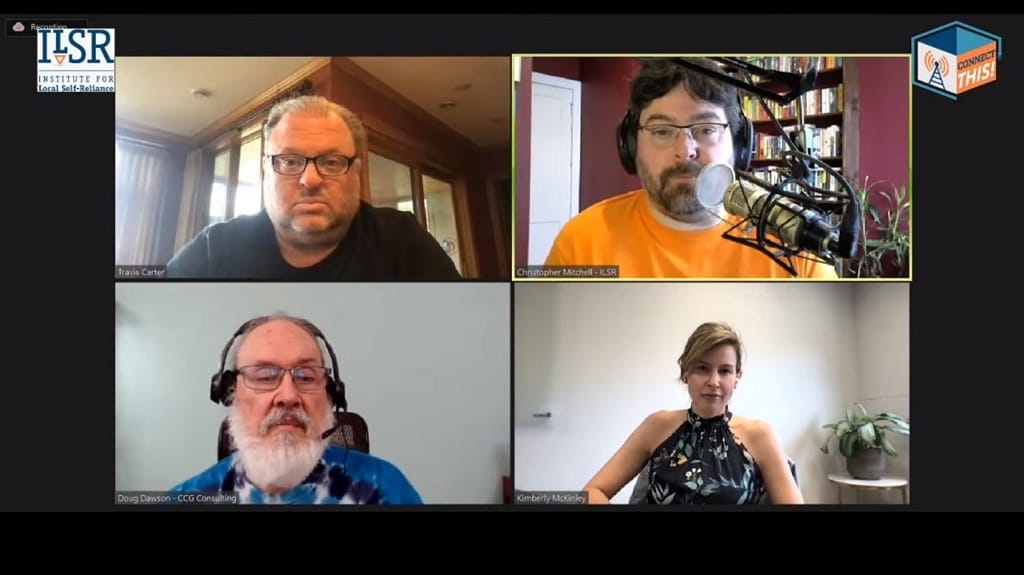Focus On Community Networks In Biden Plan A Positive 180-Degree Policy Change, Advocates Say
April 7, 2021 – Despite criticism levied against President Joe Biden’s new infrastructure plan, some broadband industry experts are excited about what it could mean for municipal and co-op networks. Biden’s “American Jobs Plan” would dedicate $100 billion for broadband infrastructure improvements ac

April 7, 2021 – Despite criticism levied against President Joe Biden’s new infrastructure plan, some broadband industry experts are excited about what it could mean for municipal and co-op networks.
Biden’s “American Jobs Plan” would dedicate $100 billion for broadband infrastructure improvements across the country, prioritizing “broadband networks owned, operated by, or affiliated with local governments, non-profits, and co-operatives,” said the White House in a statement.
Kim McKinley of UTOPIA Fiber said the announcement is a big shift from former broadband federal policy. She said they are happy to see the focus on community-owned networks, as it’s a 180-degree change from the last administration and a big step for the country, she said Monday during a “Connect This!” panel at the Institute for Local Self Reliance’s Community Broadband Network Initiative.
This would help remove the barriers to municipal broadband in the retail market, allowing municipally-owned companies to compete with the private retail companies, McKinley said. Many states have restrictions on municipal networks, including Utah where UTOPIA Fiber is based.
The pandemic has created a new reality for broadband and we don’t know what it looks like yet, said Christopher Mitchell, director for ILSR’s municipal networks project. “It involves the White House talking about this in a different way. It involves unprecedented amounts of money. It involves local leaders taking this seriously,” he said. The pandemic made people realize they need to stop talking and actually do something, he said.
Biden compared the plan to the 1936 Rural Electrification Act that loaned funds to electric companies to get power connected to every home in America. Electric co-ops were being encouraged by states at the time, and although some worked and others didn’t, that legislation was very successful in the end, Mitchell said.
“If the Biden White House is up for it, this could also be the moment in which we change our future from one in which Comcast gets us to up to $100 per month,” he said. This can be an opportunity for communities to control their own futures, he said.
“This approach is the first adult sane approach I’ve seen in the market, I mean, not because I agree with it, but because it is well thought out,” said Doug Dawson, president of CCG Consulting. This is a seismic shift and resetting the conversation, because no one at the federal level has made these proposals for many years, he said.
Biden’s price transparency
Price transparency was another benefit of Biden’s plan for the panelists.
It’s talking about more than just bringing better broadband to rural areas, it’s talking about fixing the pricing in urban areas, and for me it’s hinting at the idea for urban co-ops, Dawson said.
Lack of price transparency for fees and bait-and-switch tactics is a big problem in the broadband industry, and we like to see the effort in Biden’s plan for more price transparency, McKinley said.
But the plan has a huge uphill battle because there is already a bill sitting in front of Congress that is very different from this, Dawson said.
The Accessible, Affordable Internet for All Act, H.R. 1783, was introduced by Rep. James Clyburn, D-S.C., on March 12, and will be incorporated into the Leading Infrastructure for Tomorrow’s America (LIFT) Act, H.R. 1848, a larger infrastructure bill introduced by the Democratic delegation on the Energy and Commerce committee.
Skepticism persists
USI Fiber’s Travis Carter offered more skepticism about Biden’s plan. We’ve been talking about this for over 10 years, what will really change this time around? He asked.
Mitchell said that people can’t be silent. Officials need to hear from a lot of people that they actually want price transparency and real competition, he said. “Elected officials might be willing to force the cable industry to take a back seat to the public interest for once,” he said.
Carter also asked how effective the plan will be in large urban centers versus smaller towns and rural areas.
Bigger cities might get into this, but the big concern is how they do it, McKinley said.
When I see cities like San Francisco and Seattle, I see big time dumb politics getting in the way of this, said Mitchell, agreeing with McKinley. What cities need to do is solve the problem with “low-key smart strategic investments,” he said.
“Large cities are not necessarily going to make good ISPs, but that doesn’t mean they can’t build fiber and make it available for other people to work on it,” Dawson said.
On the American Rescue Plan
The panel also discussed federal funding that has already passed Congress, including the $3.2 billion Emergency Broadband Benefit program and the more recent $1.9 trillion American Rescue Plan that provides $340 billion to states and $130 billion to local governments for various initiatives.
The issue with the American Rescue Plan funds is how different the states will probably use it, Dawson said. Some states will put rules on the money that they pass down, others will just give it to the localities and leave it to their discretion, he said. The problem is that many cities are just going to do terrible things with this money, and if they haven’t thought about broadband, they don’t know what to do with it, so it’s not fair to just dump it on them, he said. Some cities will use it well, but others are going to have a real problem, he said.
McKinley said that cities should be able to decide how best to spend funding they receive, including the potential funding from Biden’s proposal. The funding could be used as a backstop to reduce the level of risk as cities enter into these agreements, she said. If there’s a 15-million project, and a city doesn’t want to leverage a 15-million bonding capacity, then put 5 million of funding in and then bond for 10 million, she said.
Carter argued for a different approach to spending federal funds. It shouldn’t necessarily go to cities because a lot of it will go to waste on unnecessary projects like feasibility studies, he said. The money should go to the people who will actually build the networks and get people connected, he said. The money isn’t free, we’re all paying for it, Carter said. We should want to utilize the tax dollars for maximum benefit, which is getting fiber to every home in America, he said.
The first million dollars is the biggest hurdle for getting an ISP up and running, Carter said. “The Financing piece is only 10 percent of the ISP puzzle, I mean there’s a lot of other things to do to run a successful internet provider, and financing is only a piece of it. But if you can’t get over that first 10 percent hurdle, you’re dead in the water,” he said. Small wireless internet service providers, or WISPs, are struggling to jump to fiber networks, and the money could be used to help them develop fiber plans, he suggested.
But Mitchell disagreed. Municipalities don’t need to be the perfect ideal provider, they just need to do better than a cable and telephone company that just does the bare minimum to extract the most wealth from the community, he said.
“We hear about financing being the biggest issue of these projects, and I don’t think it’s financing. A lot of these cities do have the bonding capacity to do this,” McKinley said. “It’s more about political will and having the appetite to bite off and take this challenge on.”










Member discussion